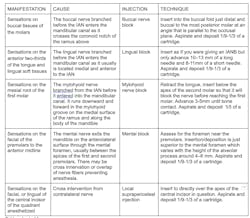Has your IA injection missed the mark? Here's how to get it right
Have you had this happen to you? After administration of a textbook-perfect inferior alveolar nerve block (IANB), the patient experiences anesthesia in most areas, but not in a certain spot. For example, everywhere was pain-free except for the molar buccal tissue, or the mesial surfaces of the first molar.
Below is a table of common localized areas that may still have sensation even after the IANB injection and how to troubleshoot anesthetizing these supplementary or branching nerves. Check out our video above for a review of the landmarks for a perfect IANB technique.
Every patient's anatomy is so different, and we can’t see underlying anomalies that may also be preventing anesthesia diffusion. These include bifurcated nerves, smaller lumens, muscles, facia, and excess bone. Other options for injections would be the Gow Gates or Vazirani-Akinosi techniques, which place the needle higher up on the nerve trunk and block accessory nerves before they branch.
(Table adapted from Malamed SF, Handbook of Local Anesthesia; Bassett KB, DiMarco AC, Naughton DK. Local Anesthesia for Dental Professionals)
Hygiene Edge was created from three dental hygiene educators who love both dentistry and education. With over 40 years of experience both in the education space and the dental field, Melia Lewis, Jessica Atkinson, and Shelley Brown love sharing their knowledge through helpful, short videos online, speaking, and working with amazing companies. You can find more information at Hygiene Edge, on YouTube (youtube.com/hygieneedge), and Instagram (@hygieneedge). Have a question or a tricky area? Let us know! We’d love to help
About the Author

Shelley Brown, MEd, BSDH, RDH
Shelley is a dental educator, speaker, content creator, and mobile clinician dedicated to advancing accessible and innovative dentistry. As co-owner of HYGIENE edgeUCATORS, she empowers dental educators through professional development. Since 2009, she has taught at the Utah College of Dental Hygiene and founded Homebound Smiles, a mobile dental practice serving underserved patients. She also runs Shelley.Dental, a YouTube and TikTok platform focused on patient education and minimally invasive dentistry.
